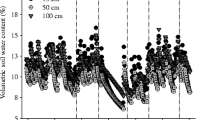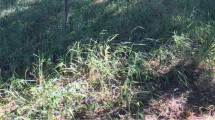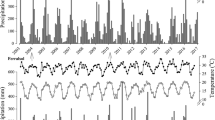Abstract
Eucalyptus and Acacia are two tree genera that are commonly used in industrial plantations and as components of agroforestry systems in southeast Asia. These fast-growing trees are mostly grown in monocultures. However, questions are now being raised about the long-term sustainability of their growth as well as their effects on site quality. Losses of N and P from the site through biomass harvest and during site preparation constitute a major nutrient drain. As an alternative to monocultures, mixed-species cultures which include at least one N2-fixing tree species can improve plant productivity and soil N dynamics. Among the various aspects of N dynamics in such stands, export of N during biomass harvest and inputs by the N2-fixing component are the most important.
Reported estimates of the amount of N fixed by acacia and other N2-fixing trees are highly variable, depending on inherited plant characteristics, tree age, site factors (e.g., drought), soil fertility (e.g., available P, metal toxicities) and unreliable methods of measuring N2-fixation. Of the available techniques for assessing N2-fixation by trees, the total N difference method (TND) is the simplest. The contribution of roots to assessments of N2-fixation is recognized but rarely measured.
For short-rotation mixed-species plantations, the amount and time of N transfer from N2-fixing trees to non-N2-fixing trees are important issues to consider when attempting to develop productive nutrient management strategies. Based on limited information from trials in southeast Asia, it appears that acacia fixes substantial amounts of N during the first few years of establishment and a significant amount of that N is transferred to adjacent eucalypts, thereby improving the growth and nutrition of the eucalypts. The presumed transfer of N from acacias to eucalypts during the early stages of plantation development probably results from belowground turnover of roots and nodules because aboveground litter decomposition is slight at this stage, and contributes little to the overall N dynamics.
The available information on P cycling in mixed-species stands, during the early stages of stand growth, provides inconclusive evidence as to whether the availability of soil P increases, despite indications of higher levels of phosphatase activity in the fine roots of nitrogen-fixing trees. This would imply that additional inputs of P as fertilizer are required to remove any P deficiency in mixed-species stands. Long-term observations are required for better understanding of the nutritional and growth benefits of including N2-fixing trees in mixed-species stands.
Similar content being viewed by others
References
Adams MA and Attiwill PM (1984) Role of Acacia spp. in nutrient balance and cycling in regenerating Eucalyptus regnans F. Muell. forests. II. Field studies of acetylene reduction. Aust J Bot 32: 217–223
Ball JB, Wormald TJ and Russo L (1995) Experience with mixed and single species plantations. Commonwealth For Rev 74: 301–304
Bargali SS, Singh RP and Singh SP (1992) Structure and function of an age series of eucalypt plantations in central Himalaya. II. Nutrient dynamics. Annals of Bot 69: 413–421
Bernhard-Reversat F (1988) Soil nitrogen mineralization under a Eucalyptus plantation and a natural Acacia forest in Senegal. For Ecol Manage 23: 233–244
Binkley D (1983) Ecosystem production in Douglas-fir plantations: interactions of red alder and site fertility. For Ecol Manage 5: 215–227
Binkley D (1992) Mixtures of N2-fixing and non-N2-fixing species. In: Cannell MGR, Malcolm DC and Robertson PA (eds) The Ecology of Mixed-Species Stands of Trees, pp 99–123. Blackwell Sci Publi, London
Binkley D, Dunkin KA, DeBell D and Ryan MG (1992a) Production and nutrient cycling in mixed plantations of Eucalyptus and Albizia in Hawaii. Forest Sci 38: 393–408
Binkley D, Sollins P, Bell R, Sachs D and Myrold D (1992b) Biogeochemistry of adjacent conifer and alder-conifer stands. Ecology 73: 2022–2033
Bruijnzeel LA (1990) Hydrology of moist tropical forests and effects of conversion: a state of knowledge review. UNESCO — IHP, Humid Tropics Program, Paris
Brown AHF (1992) Functioning of mixed-species stands at Gisburn, NW England. In: Cannell MGR, Malcolm DC and Robertson PA (eds) The Ecology of Mixed-Species Stands of Trees, pp 125–150. Blackwell Sci Publi, London
Bunyavejchewin S (1989) Primary production of plots of five young close-spaced fast-growing tree species. III. Dry matter and nutrient content of litterfall. Nat Hist Bull Siam Soc 37: 65–73
Bunyavejchewin S, Kiratiprayoon S and Kumpun T (1989) Primary production of plots of five young close-spaced fast-growing tree species. II. Above-ground biomass, nutrient and energy content. Nat Hist Bull Siam Soc 37: 57–63
Cole D, Compton J, Van Micgroct H and Homann P (1990) Changes in soil properties and site productivity caused by red alder. Water Air Soil Pollut 54: 231–246
Danso SKA, Bowen GD and Sanginga N (1992) Biological fixation in trees in agro-ecosystems. Plant Soil 141: 177–196
DeBell DS, Whitesell CD and Schubert TH (1985) Mixed plantations of Eucalyptus and leguminous trees enhance biomass production. Research Paper, Pacific-Southwest Forest and Range Experiment Station, USDA Forest Service, No. PSW-175
DeBell DS, Whitesell CD and Schubert TH (1989) Using N2-fixing Albizia to increase growth of Eucalyptus plantations in Hawaii. For Sci 35: 64–75
Denslow JS, Vitousek PM and Schultz JC (1987) Bioassay of nutrient limitations in a tropical rain forest soil. Oecologia 74: 370–376
Duhoux E and Dommergues YR (1985) The use of nitrogen fixing trees in forestry and soil restoration in the tropics. In: Ssali H and Keya SO (eds) Biological Nitrogen Fixation in Africa, pp 384–400. Nairobi MIRCEN, Nairobi, Kenya
El-Lakany MH and Mohamed SY (1993) Effects of species combination on the root characteristics of young Acacia saligna, Casuarina cunninghamiana and Eucalyptus camaldulensis trees. Alexandria J Agricultural Res 38: 211–227
Ewel JJ (1986) Designing agricultural ecosystems for the humid tropics. Annual Review of Ecology and Systematics 17: 245–271
Fölster H and Khanna PK (1997) Dynamics of nutrient supply in plantation soils. In: Nambiar EKS and Brown A (eds) Better Management of Soil, Nutrients and Water in Tropical Plantation Forests. ACIAR, Canberra, Australia (in press)
FAO (1992) Mixed and pure forest plantations in the tropics and sub-tropics. FAO Forestry paper 103 (based on the work of T.J. Wormald). FAO of the UN, Rome, Italy
FAO (1995) Plantations in tropical and subtropical regions — mixed and pure. FAO of the UN, Rome, Italy
Gauthier D, Diem HG, Dommergues YR and Ganry F (1985) Assessment of N2 fixation by Casuarina equisetifolia inoculated with Frankia ORS021001 using 15N methods. Soil Bio Biochem 17: 375–379
Giardina CP, Huffman S, Binkley D and Caldwell BA (1995) Alders increase soil phosphorus availability in a Douglas-fir plantation. Can J For Res 25: 1652–1657
Giller KE and Wilson KJ (1991) Nitrogen fixation in tropical cropping systems. CAB Int, Wallingford, United Kingdom
Gillespie AR and Pope PE (1990) Rhizosphere acidification increases phosphorus recovery of black locust: I. Model predictions and measured recovery. Soil Sci Soc Am J 54: 538–541
Grove TS and Malajczuk N (1981) Nitrogen inputs to Eucalyptus marginata and E. diversicolor forests. In: Rummery RA and Hingston FJ (eds) Managing Nitrogen Economies of Natural and Man Made Ecosystems, pp 199–204. CSIRO, Perth, WA
Hansen AP, Pate JS, Hansen A and Bell DT (1987) Nitrogen economy of post-fire stands of shrub legumes in jarrah (Eucalyptus marginata) forests of SW Australia. J Exp Bot 38: 26–41
Hansen EA and Dawson JO (1982) Effect of Alnus glutinosa on hybrid Populus height growth in a short rotation intensively cultured plantation. Forest Sci 28: 49–59
Högberg P and Kvarnström M (1982) Nitrogen fixation by the woody legume Leucaena leucocephala in Tanzania. Plant Soil 66: 21–28
Johnson DW and Lindberg SE (eds) (1992) Atmospheric Deposition and Forest Nutrient Cycling. Springer Verlag, New York
Kelty MJ (1992) Comparative productivity of monocultures and mixed-species stands. In: Kelty MJ (ed) The Ecology and Silviculture of Mixed-Species Forests, pp 125–141. Kluwer Academic Publ., The Netherlands
Khanna PK (1997) Comparison of growth and nutrition of young monocultures and mixed stands of Eucalyptus globulus and Acacia mearnsii. Forest Ecol Manage 94: 105–113
Knowles R (1980) Nitrogen fixation in natural plant communities and soil. In: Bergersen FJ (ed) Methods for Evaluating Biological Nitrogen Fixation, pp 557–582. Wiley, New York
Langkamp PJ, Swinden LB and Dalling MJ (1979) Nitrogen fixation (acetylene reduction) by Acacia pellita on areas restored after mining at Groote Eylandt, Northern Territory. Aust J Botany 27: 353–361
Langkamp PJ and Dalling MH (1981) Managing the nitrogen economies of rehabilitated sites on Groote Eylandt. In: Rummery RA and Hingston FJ (eds) Managing Nitrogen Economies of Natural and Man Made Ecosystems, pp 170–176. CSIRO, Perth, WA
Lawrie AC (1981) Nitrogen fixation by native Australian legumes. Aust J Bot 29: 143–157
Liya SM, Odu CTI, Agboola AA and Mulongoy K (1990) Estimation of N2 fixation by nitrogen fixing trees in the subhumid tropics using 15-N dilution and difference methods. Paper presented at the fourth African Association for Biological Nitrogen Fixation. HTA. Ibadan, 24–28 Sept 1990
Lugo AE, Wang D and Bormann FH (1990) A comparative analysis of biomass production in five tropical tree species. For Ecol Manage 31: 153–166
Mafongoya PL, Giller KE and Palm CA (1997) Decomposition and nutrient release patterns of tree prunings and litter. Agroforestry Systems 38: 77–97
Miller HG (1995) The influence of stand development on nutrient demand, growth and allocation. Plant Soil 168/169: 225–232
Montagnini F, Gonzalez E, Porras C and Rheingans R (1995) Mixed and pure forest plantations in the humid neotropics: a comparison of early growth, pest damage and establishment costs. Commonwealth For Rev 74: 306–314
Motavalli PP, Palm CA, Elliot ET, Frey SD and Smithson PC (1995) Nitrogen mineralization in humid tropical soils: mineralogy, texture, and measured nitrogen fractions. Soil Sci Soc Am J 59: 1168–1175
Nambiar EKS (1990/91) Management of forests under nutrient and water stress. Water, Air and Soil Pollution 54: 209–230
Ndoye I and Dreyfus B (1988) N2 fixation by Sesbania rostrata and Sesbania sesban estimated using 15N and total N difference methods. Soil Bio Biochem 20: 209–213
Ndoye I, Gueye M, Danso SKA and Dreyfus B (1995) Nitrogen fixation in Faidherbia albida, Acacia raddiana, Acacia senegal and Acacia seyal estimated using the 15N isotope dilution technique. Plant Soil 172: 175–180
Nykvist N (1997) Uptake of nutrients in a plantation of Acacia mangium in relation to decrease in soil amounts. J Sustainable Forestry 4(1/2): 131–139
Ong CK and Huxley P (eds) (1996) Tree-Crop Interactions: a physiological approach. CAB International, Wallingford, UK
Oreahrd ER and Darb GD (1956) Fertility changes under continual wattle culture with special reference to nitrogen and base status of the soil. Trans 6th Intern Congr Soil Sci, Paris, 1956, Vol. D, pp 305–310
Pandey D (1995) Forest resources assessment 1990. Tropical forest plantation resources. FAO Forestry paper 128. FAO, Swedish University of Agricultural Sciences, Swedish International Development Cooperation Agency
Raison RJ, Connell MJ and Khanna PK (1987) Methodology for studying fluxes of soil mineral-N in situ. Soil Biol Biochem 19: 521–530
Rennie RJ and Rennie AD (1983) Techniques for quantifying N2 fixation in association with non-legumes under field and greenhouse conditions. Can J Microbiol 29: 1022–1035
Roskoski JP (1981) Nodulation and N2-fixation by Inga jinicuil, a woody legume in coffee plantations. I. Measurements of nodule biomass and field C2H2 reduction rates. Plant Soil 59: 201–206
Roskoski JP, Montano J, van Kessel C and Catillejo G (1982) Nitrogen fixation by tropical woody legumes: potential source of soil enrichment. In: Graham PH and Harris SC (eds) BNF Technology for Tropical Agriculture, pp 447–454. CIAT, Cali, Colombia
Samraj P, Chinnamani S and Haldorai B (1977) Natural versus man-made forests in Nilgiris with special reference to run-off, soil loss and productivity. Indian Forester 103: 460–465
Sanginga N, Mulongoy K and Ayanaba A (1985) Effect of nodulation and mineral nutrients on nodulation and growth of Leucaena leucocephala. In: Ssali H and Keya SO (eds) Biological Nitrogen Fixation in Africa, pp 419–427. Nairobi MIRCEN, Nairobi, Kenya
Sanginga N, Danso SKA and Bowen GD (1989) Nodulation and growth of Allocasuarina and Casuarina species to phosphorus fertilization. Plant Soil 118: 125–132
Sanginga N, Bowen GD and Danso SKA (1991) Intra-specific variation in growth and P accumulation of Leucaena leucocephala and Gliricidia sepium as influenced by soil phosphate status. Plant Soil 133: 201–208
Sanginga N, Vanlauwe B and Danso SKA (1995) Management of biological N2 fixation in alley cropping systems: estimation and contribution to N balance. Plant and Soil 174: 119–141
Sanginga N, Zapata F, Danso SKA and Bowen GD (1990) Effect of successive cutting on nodulation and nitrogen fixation of Leucaena leucocephala using 15N dilution and the difference methods. In: van Beusichem ML (ed) Plant Nutrition-Physiology and Application, pp 667–674. Kluwer Academic Publ., Dordrecht, The Netherlands
Sanginga N, Zapata F, Danso SKA and Bowen GD (1992) Estimating nitrogen fixation in Leucaena and Gliricidia using different 15N labelling methods. In: Mulongoy K, Gueye M and Spencer DC (eds) Biological Nitrogen Fixation and Sustainability of Tropical Agriculture, pp 265–275. Wiley-Sayce and AABNF co-publication, Chichester, UK
Shearer G and Kohl H (1986) N2-fixation in field settings: estimations based on natural 15N abundance. Aust J Plant Physiol 13: 699–757
Sim BL and Nykvist N (1991) Impact of forest harvesting and replanting. J Tropical Forest Sci 3: 251–284
Snedecor GW and Cochran WG (1967) Statistical Methods, 6th ed. Iowa State Univ Press, Ames, Iowa, USA
Sougoufara B, Danso SKA, Diem HG and Dommergues YR (1990) Estimating N2 fixation and N derived from soil by Casuarina equisetifolia using labelled 15N fertilizer: some problems and solutions. Soil Biol Biochem 22: 695–701
Sun JS, Simpson RJ and Sands R (1992) Nitrogenase activity of two genotypes of Acacia mangium as affected by phosphorus nutrition. Plant Soil 144: 51–58
Szott LT, Fernandes ECM and Sanchez PA (1991) Soil-plant interactions in agroforestry systems. For Ecol Manage 45: 127–152
Tsai SM, Da Silva PM, Cabezas WL and Bonetti R (1993) Variability in nitrogen fixation of common bean (Phaseolus vulgaris L.) intercropped with maize. Plant Soil 152: 93–101
Turvey ND, Attiwill PM, Cameron JN and Smethurst PJ (1983) Growth of planted pine trees in response to variation in the densities of naturally regenerated acacias. For Ecol Manage 7: 103–117
Vandermeer J (1989) The Ecology of Intercropping. Cambridge Univ Press, Cambridge, UK
Witkowski ETF (1991) Effects of invasive alien acacias on nutrient cycling in the coastal lowlands of the Cape Fynbos. J Applied Ecol 28: 1–15
Yadav JP, Sharma KK and Khanna P (1993) Effect of Acacia nilotica on mustard crop. Agroforestry Systems 21: 91–98
Zou X (1993) Species effects on earthworm density in tropical tree plantations in Hawaii. Biol and Ferti Soils 15: 35–38
Zou X, Binkley D and Doxtader KG (1993) A new method for estimating gross phosphorus mineralization and immobilization rates in soils. Plant and Soil 147(1): 243–250
Zou X, Binkley D and Caldwell BA (1995) Effects of dinitrogen-fixing trees on phosphorus biogeochemical cycling in contrasting forests. Soil Sci Soc Am J 59: 1452–1458
Author information
Authors and Affiliations
Rights and permissions
About this article
Cite this article
Khanna, P.K. Nutrient cycling under mixed-species tree systems in southeast Asia. Agroforestry Systems 38, 99–120 (1997). https://doi.org/10.1023/A:1005952410569
Issue Date:
DOI: https://doi.org/10.1023/A:1005952410569




